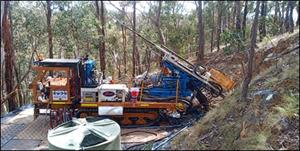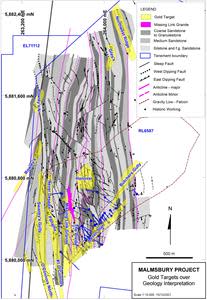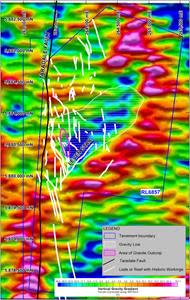Labrador Gold: https://labradorgold.com/
Ticker: TSX.V: LAB | OTCQX: NKOSF
Corporate Presentation: https://labradorgold.com/investors/presentations/
Telephone: (416) 704-8291
Email: info@labradorgold.com
Labrador Gold Intersects 54.17 G/T Au Over 0.95m at the Big Vein Target
TORONTO, May 05, 2022 (GLOBE NEWSWIRE) — Labrador Gold Corp. (TSX.V:LAB | OTCQX:NKOSF | FNR: 2N6) (“LabGold” or the “Company”) is pleased to announce the continued extension of the Big Vein Zone to the southwest with an intersection of 54.17 g/t Au over 0.95m as well as the intersection of near surface gold mineralization from initial diamond drilling of the Pristine target at its 100% controlled Kingsway project near Gander, Newfoundland. These holes were drilled as part of the Company’s ongoing 100,000 metre drill program at Kingsway.
At Big Vein, the intercept of 54.17g/t Au over 0.95m in hole K-22-122 contains visible gold and is the furthest intersection of the Big Vein Zone to the southwest drilled to date. This extends the strike length of the zone to 320m and it remains open in this direction. Hole K-22-116 targeted the HTC zone and intersected 14.67 g/t over a 1m interval that also contained visible gold.
At the Pristine target the first six holes all intersected significant near surface gold mineralization, including hole K-21-109 that assayed 3.55 g/t Au over 2.33m from 17.15m that contained visible gold and hole K-21-100 that intersected 3.89 g/t Au over 3m from 53m downhole.
The initial assays from the Pristine target, located approximately 800m northeast of Big Vein along the Appleton Fault Zone, are very similar to the first reported holes from Big Vein that assayed 1.11 g/t Au over 5.50m, 5.0 g/t Au over 0.9m and 2.26 g/t Au over 7.0m in Hole K-21-01 and 1.72 g/t Au over 3.0min Hole K-21-02 (see news release dated May 10, 2021).
The stratigraphy encountered is also very similar to Big Vein, with the mineralized Doyle Zone defined by a network of shear veining that is associated with a highly fractured sandstone in fault contact with a deformed black graphitic shale.
“We are very pleased with the initial results from the Pristine target which proves our interpretation of the existence of a gold occurrence not too far up ice from the pristine gold grains found in till. Pristine is the third of three targets tested to date to show significant near surface gold assays, a result of our systematic exploration strategy at Kingsway and the prospectivity of the Appleton Fault Zone,” said Roger Moss, President and CEO of the LabGold. “We have named the mineralized zone at Pristine the Doyle Zone after our friend and strong supporter James Doyle, who passed away suddenly, and much too early, in late 2020. James helped and advised us in every financing since the start of Labrador Gold in 2017, and gave us support in the market, often when no-one else was interested. James would have loved witnessing all the exploration activity in central Newfoundland over the last two years and would have been working the telephones daily. We will endeavour to ensure that the Doyle Zone lives up to the big personality of its namesake.”
Pristine Target and Appleton Fault Zone
The visible gold found in hole K-21-109 drilled into the Doyle Zone is the third occurrence of visible gold found, after Big Vein and Golden Glove, along the Appleton Fault Zone. The Doyle Zone is the furthest northeast, approximately 4.5km from Golden Glove which lies close to the southern property boundary. The Doyle Zone lies to the east of a fault with a major damage zone approximately 30m wide which may represent the expression of the Appleton Fault Zone in this area. Further work is necessary to determine if this is, in fact, the the case or if it is a major splay of the Appleton Fault Zone. In either case it is a significant structure associated with gold mineralization in the Doyle Zone.
The most detailed exploration along the Appleton Fault Zone to date has been over an approximately 2km section from just southwest of Big Vein to the Pristine target, leaving the remaining 10km length of the fault zone relatively underexplored. This will be a major focus of LabGold’s upcoming field program.
| Hole ID | from (m) | to (m) | width (m) | Au (g/t) | Target |
| K-22-142 | 96 | 100 | 4 | 3.44 | Big Vein |
| including | 97 | 99 | 2 | 5.37 | |
| K-22-125 | 70 | 77 | 7 | 1.72 | HTC |
| K-22-124 | 264 | 266 | 2 | 2.03 | Big Vein |
| 283 | 284 | 1 | 7.68 | ||
| K-22-122 | 99 | 114 | 15 | 1.46 | Big Vein |
| 123.33 | 124.28 | 0.95 | 54.17* | ||
| K-22-116 | 178 | 179 | 1 | 14.67* | HTC |
| 194 | 196 | 2 | 4.18 | ||
| 207 | 208 | 1 | 3.25 | ||
| K-22-143 | 75 | 82 | 7 | 1.53 | Pristine |
| K-22-123 | 23 | 24 | 1 | 1.98 | Pristine |
| 43 | 44 | 1 | 2.3 | ||
| K-22-119 | 31 | 33 | 2 | 1.92 | Pristine |
| K-21-109 | 17.15 | 18.3 | 2.3 | 3.55* | Pristine |
| 47.45 | 50.45 | 3 | 1.31 | ||
| 54.45 | 59.45 | 5 | 1.48 | ||
| K-21-107 | 48 | 52 | 4 | 1.16 | Pristine |
| 86 | 89 | 3 | 1.58 | ||
| 96 | 103 | 7 | 1.81 | ||
| K-21-100 | 53 | 56 | 3 | 3.89 | Pristine |
Table 1. Summary of Assay Results
* Interval contains visible gold. All intersections are downhole length
as there is insufficient Information to calculate true width.
| Hole ID | Northing | Easting | Elevation (m) | Azimuth | Dip | Depth (m) |
| K-22-143 | 5436034 | 661801 | 54.1 | 260 | 45 | 299.06 |
| K-22-142 | 5435015 | 661426 | 36.8 | 155 | 45 | 167.00 |
| K-22-125 | 5435283 | 661600 | 42.5 | 140 | 50 | 326.00 |
| K-22-124 | 5435143 | 661405 | 50.2 | 140 | 60 | 494.00 |
| K-22-123 | 5436103 | 661808 | 56.1 | 300 | 45 | 236.00 |
| K-22-122 | 5435016 | 661426 | 36.9 | 145 | 50 | 228.63 |
| K-22-119 | 5436105 | 661803 | 56.2 | 300 | 45 | 185.00 |
| K-21-116 | 5435280 | 661600 | 42.3 | 145 | 60 | 236.00 |
| K-21-109 | 5436058 | 661789 | 55.5 | 260 | 60 | 218.00 |
| K-21-107 | 5436058 | 661789 | 55.6 | 295 | 50 | 209.00 |
| K-21-100 | 5436191 | 661851 | 58.6 | 140 | 45 | 230.00 |
Table 2. Drill hole collar details
Figure 1. Doyle Zone plan map
https://www.globenewswire.com/NewsRoom/AttachmentNg/d658d985-d462-4293-a32f-4db3365c5d7d
Figure 2. Big Vein Plan Map.
https://www.globenewswire.com/NewsRoom/AttachmentNg/44a9f7c4-1910-4bea-99a8-e815f6ef56c2
QA/QC
True widths of the reported intersections have yet to be calculated. Assays are uncut. Samples of HQ split core are securely stored prior to shipping to Eastern Analytical Laboratory in Springdale, Newfoundland for assay. Eastern Analytical is an ISO/IEC17025 accredited laboratory. Samples are routinely analyzed for gold by standard 30g fire assay with atomic absorption finish as well as by ICP-OES for an additional 34 elements. Samples containing visible gold are assayed by metallic screen/fire assay, as are any samples with fire assay results greater than 1g/t Au. The company submits blanks and certified reference standards at a rate of approximately 5% of the total samples in each batch.
Qualified Person
Roger Moss, PhD., P.Geo., President and CEO of LabGold, a Qualified Person in accordance with Canadian regulatory requirements as set out in NI 43-101, has read and approved the scientific and technical information that forms the basis for the disclosure contained in this release.
The Company gratefully acknowledges the Newfoundland and Labrador Ministry of Natural Resources’ Junior Exploration Assistance (JEA) Program for its financial support for exploration of the Kingsway property.
About Labrador Gold
Labrador Gold is a Canadian based mineral exploration company focused on the acquisition and exploration of prospective gold projects in Eastern Canada.
In early 2020, Labrador Gold acquired the option to earn a 100% interest in the Kingsway project in the Gander area of Newfoundland. The three licenses comprising the Kingsway project cover approximately 12km of the Appleton Fault Zone which is associated with gold occurrences in the region, including those of New Found Gold immediately to the south of Kingsway. Infrastructure in the area is excellent located just 18km from the town of Gander with road access to the project, nearby electricity and abundant local water. LabGold is drilling a projected 50,000 metres targeting high-grade epizonal gold mineralization along the Appleton Fault Zone following encouraging early results. The Company has approximately $28 million in working capital and is well funded to carry out the planned program.
The Hopedale property covers much of the Florence Lake greenstone belts that stretches over 60 km. The belt is typical of greenstone belts around the world but has been underexplored by comparison. Work to date by Labrador Gold show gold anomalies in rocks, soils and lake sediments over a 3 kilometre section of the northern portion of the Florence Lake greenstone belt in the vicinity of the known Thurber Dog gold showing where grab samples assayed up to 7.8g/t gold. In addition, anomalous gold in soil and lake sediment samples occur over approximately 40 km along the southern section of the greenstone belt (see news release dated January 25 th 2018 for more details). Labrador Gold now controls approximately 40km strike length of the Florence Lake Greenstone Belt.
The Company has 156,439,526 common shares issued and outstanding and trades on the TSX Venture Exchange under the symbol LAB.
For more information please contact:
Roger Moss, President and CEO Tel: 416-704-8291
Or visit our website at: www.labradorgold.com
Twitter: @LabGoldCorp
Neither TSX Venture Exchange nor its Regulation Services Provider (as that term is defined in policies of the TSX Venture Exchange) accepts responsibility for the adequacy or accuracy of this release .
Forward-Looking Statements: This news release contains forward-looking statements that involve risks and uncertainties, which may cause actual results to differ materially from the statements made. When used in this document, the words “may”, “would”, “could”, “will”, “intend”, “plan”, “anticipate”, “believe”, “estimate”, “expect” and similar expressions are intended to identify forward-looking statements. Such statements reflect our current views with respect to future events and are subject to risks and uncertainties. Many factors could cause our actual results to differ materially from the statements made, including those factors discussed in filings made by us with the Canadian securities regulatory authorities. Should one or more of these risks and uncertainties, such as actual results of current exploration programs, the general risks associated with the mining industry, the price of gold and other metals, currency and interest rate fluctuations, increased competition and general economic and market factors, occur or should assumptions underlying the forward looking statements prove incorrect, actual results may vary materially from those described herein as intended, planned, anticipated, or expected. We do not intend and do not assume any obligation to update these forward-looking statements, except as required by law. Shareholders are cautioned not to put undue reliance on such forward-looking statements .






























